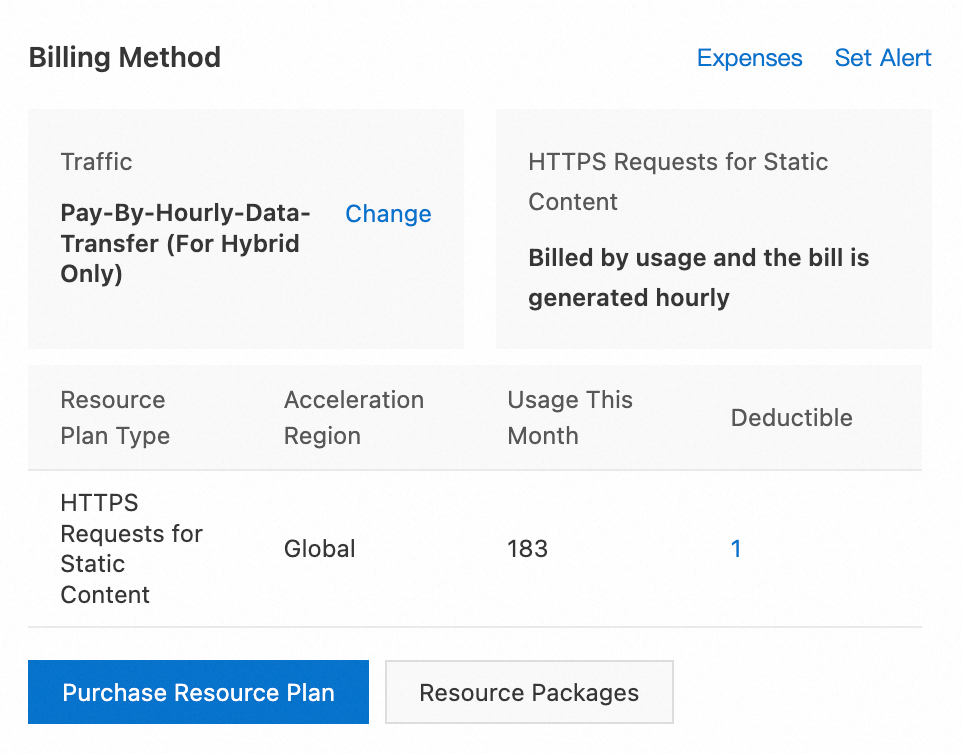The Overview page provides four panels for common features: Configuration Wizard, Access Data, Status Codes, and Metering Methods.
Getting Started

This module is automatically hidden if you have more than 30 domain names.
Account domain name dashboard
This section displays the total number of domain names in your account and the number of domain names in each of the following three states: Running, Stopped, and Configuring.
Running domain names dashboard
For domain names in the Running state, this section shows the number of domain names that are Configured or Not Configured for the following items: CNAME, Time-to-live, and SSL Certificate. When you move the pointer over a number, the corresponding domain names are displayed.
Configuration item | Required | Description |
CNAME | Required | A CNAME is a type of DNS record. It is required to ensure that your accelerated domain name works correctly with Alibaba Cloud CDN. |
Time-to-live | Recommended | The time-to-live (TTL) specifies how long resources from your origin server are cached on CDN nodes. When the TTL expires, the node marks the resource as invalid. Setting a proper TTL improves the cache hit ratio and user experience. |
SSL Certificate | Recommended | An SSL Certificate encrypts data between clients and CDN nodes. This allows your accelerated domain name to be accessed over the HTTPS protocol. |
Access data

This module displays statistics for Bandwidth, Traffic, and the number of Requests for all accelerated domain names in your account. You can view data for different time ranges, such as Today, Yesterday, and Last 7 Days.
Click the > button for a time range to go to the Usage Query page. There, you can query data for a single accelerated domain name or view more detailed access data for a custom time range.
Status codes

This module displays statistics for the HTTP status codes returned to clients for different time ranges, such as Today, Yesterday, and Last 7 Days. The statistics include the number and percentage of 2xx Success, 4xx Client Error, and 5xx Server Error responses.
For example, the percentage of 4xx Client Error edge responses is the number of 4xx Client Error edge responses divided by the total number of edge responses.
Click the > button for a time range to go to the Resource Monitoring page. There, you can query data for a single accelerated domain name or view more detailed HTTP status code data for a custom time range.
2xx Success - Edge Response: The CDN node successfully processed the request from the client. The server returned the requested resource or a confirmation.
4xx Client Error - Edge Response: The CDN node cannot process the request from the client because the request is invalid. For example, the client may have insufficient permissions. You can modify the client request and try again.
4xx Client Error - Origin-fetch Response: The origin server cannot process the origin-fetch request from the CDN node because the request is invalid. For example, the requested resource does not exist. You can modify the client request or adjust the accelerated domain name configuration, and then try again.
5xx Server Error - Edge Response: An internal error occurred on the CDN node while it was processing a client request. For example, the CDN node may be overloaded. Check your origin server configuration, such as its network settings.
5xx Server Error - Origin-fetch Response: An internal error occurred on the origin server when the CDN node attempted to fetch a resource. For example, the origin server may be overloaded. Check your origin server configuration, such as its server load.
Metering methods

Metering method display
This module displays the metering methods for your account's Alibaba Cloud CDN basic services (Traffic) and HTTPS requests for static content.
By default, basic services (Traffic) use the pay-by-data-transfer metering method. To change the method, click the Change button to change the metering method. The metering method for HTTPS Requests For Static Content is Pay-by-data-transfer, Billed Hourly and cannot be changed.
Resource plan information
Detailed usage information for resource plans is displayed only when the metering method for basic services (Traffic) is Pay-by-data-transfer.
When the metering method for basic services (Traffic) is not Pay-by-data-transfer, resource plans are not used to offset data transfer, even if you have purchased them. In this case, fees are deducted from your account balance. For more information, see Why am I charged or have an overdue payment after I purchased a resource plan?
This module displays information about your purchased Alibaba Cloud CDN resource plans that are valid and have a remaining balance greater than 0.
Item | Description | Example |
Resource Plan Type | Outbound data transfer (GB), , etc. | |
Acceleration Region | The acceleration regions where the outbound data transfer plan can be used. | Global (the Chinese mainland), Asia Pacific 1, Asia Pacific 2, Asia Pacific 3, North America, Europe, Middle East/Africa, South America. |
Current Month Usage | The amount of the resource plan used in the current month. |
|
Deductible Resource Plans | Number of resource plans |
|
Click the Resource Plan Management button to view more details about your resource plans, such as the total quota, remaining quota, and expiration date. For more information, see Resource Plan Management.